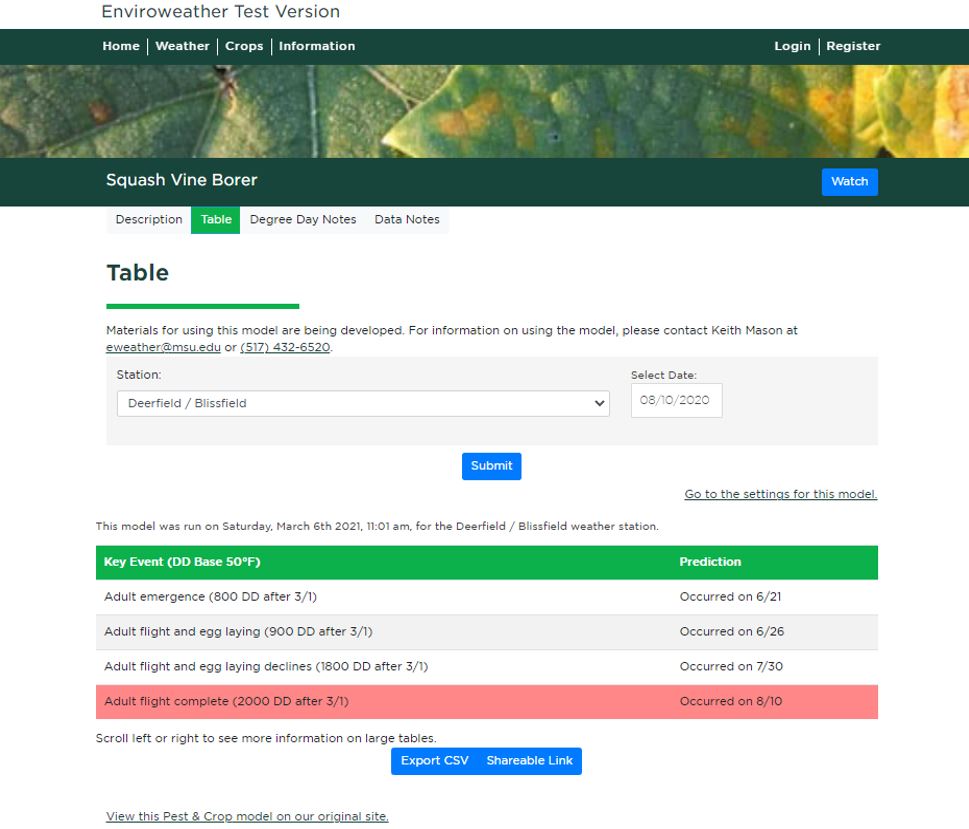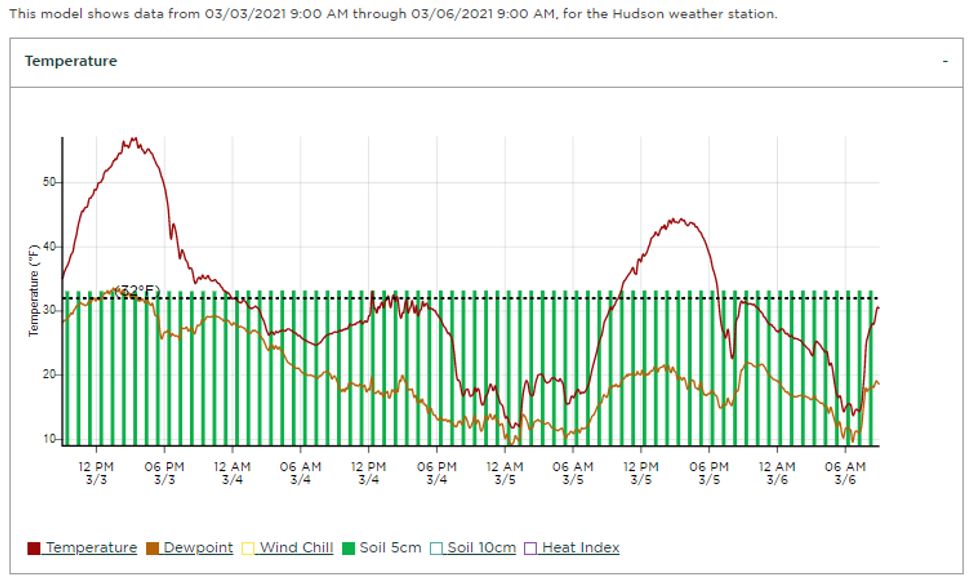Improve your garden with MSU Enviroweather’s tools and information
Enviroweather’s weather-based models and forecasting interpret Michigan’s conditions to help gardeners make better decisions about plant care and pest management.

What is Enviroweather?
Michigan gardeners are lucky to have one of the country’s few weather-based pest and plant management web resources coordinated by Michigan State University and its partners. Enviroweather is a network of 101 remote weather stations in Michigan (91) and Wisconsin (10) that record local environmental conditions, and those data are fed into models and tools to help growers make local decisions.

How is Enviroweather relevant to gardeners?
Although Enviroweather was originally designed to provide Michigan commercial agriculture with access to local weather information and a suite of weather-based tools for managing a variety of crops, many of these applications are also important for home and community gardens. The tools available on this free online resource include summaries of weather conditions, models that predict pest, disease and crop development and water-use tools. Links to some of these relevant tools are embedded in the text below.
The arrival of insects or diseases in the garden can often be predicted based on temperature and other environmental factors. Growing degree days are a measure of heat accumulation and can predict when pests or plants will reach critical life stages where they can damage plants or create nuisance issues. Thus, residential gardeners can be more prepared for managing annual risks such as squash vine borer in squash and melons (also known as cucurbits, see Figure 1), codling moths in apples or scale insects on magnolia.
Instead of reacting after pest problems occur, gardeners can use Enviroweather’s growing degree day models and weather-based tools to predict when pest problems are expected to occur. With these tools, gardeners can be proactive and identify times when they need to make decisions about protecting plants from damaging insect pests or to limit the development of plant diseases. If you live near one of these stations, consider using data from there to track precipitation to determine watering needs or if soil temperatures have warmed sufficiently to begin spring plantings.
Useful weather tools for gardeners include the Meteogram (Figure 2), which is a graphical display of recent conditions (from the last 6 hours to the last week) including air and soil temperatures, wind speed and potential evapotranspiration, and more. The Degree Day and Rainfall summary provides daily and cumulative values of growing degree days, temperature and rainfall, which includes five days of forecast temperatures and three days of forecast for rainfall for planning in the near-term.
To assist with irrigation decisions, Enviroweather offers the Potential Evapotranspiration Daily Summary that provides the amount of water that is expected to be lost through evaporation from the soil and plant transpiration using current and forecast conditions.

Michigan gardeners interested to learn when deciduous trees or perennial flowers are expected to bloom can also benefit from degree day forecasting. These provide an estimated range and are a useful tool for planning a landscape with plants that bloom across the growing season or for the individual who is simply curious to find out when different trees and shrubs have open flowers (Photo 1).
Enviroweather also includes tools for tracking plant development, and the Fraser Fir model is a good example of that. Degree day models could be designed differently based on regional conditions. It is best to consider models designed for pests, plants and pathogens in the Midwest or Northeast.
In addition to the applications on Enviroweather, MSU Extension and the MSU Turfgrass Program have an additional tool, GDD Tracker, that provides decision-making support for managing weeds or applying a preemergent herbicide in areas planted in grass in your yard. Both Enviroweather and GDD Tracker will benefit the novice or experienced gardener and provide data that is useful for managing home or community gardens.
Recent updates to Enviroweather
The Enviroweather program has a newly redesigned website, and a test version went live in August 2020 and can be accessed directly at: alpha.enviroweather.msu.edu. Users will also find links on most Enviroweather web pages that connect models on the new and current website. This arrangement lets users switch back and forth between website versions as needed and makes it easier to become familiar with the layout and functions of the new website.
The new design is easier to use than the current website, and it is geared toward viewing on smartphones and tablets. Additionally, users can create an account and save preferences on a dashboard. This will provide faster access to the crop and pest models and weather information that is most important for each user’s needs. You can also get help using Enviroweather or provide feedback on the new site with the Feedback Form.
To help users adjust to the new site, User Guides are available through the Information link on the menu bar near the top of the page. In addition, each model or tool on the website will have a “Description” tab that contains additional information on running and interpreting the model to help with decision making.
If you are interested in learning more about how Enviroweather can be used to predict pest arrival and improving pest management in the residential garden, register for a free MSU Extension webinar on April 6 at 12 p.m.
Announcements for additional training opportunities will be shared through MSU Extension News, so if you haven’t done so already, be sure to sign up for MSU Extension News Digests for the topics that are most relevant for you.
You can always contact Enviroweather program coordinator Keith Mason at masonk@msu.edu or 517-355-3897 for assistance with the tools and features on either website.
This work is supported by the Crop Protection and Pest Management Program 2017-70006-27175 from the USDA National Institute of Food and Agriculture. Any opinions, findings, conclusions or recommendations expressed in this publication are those of the author(s) and do not necessarily reflect the view of the U.S. Department of Agriculture.



 Print
Print Email
Email